
One-room schools were commonplace throughout rural portions of various countries, including Prussia, Norway, Sweden, the United States, Canada, Australia, New Zealand, the United Kingdom, Ireland, and Spain. In most rural and small town schools, all of the students met in a single room. There, a single teacher taught academic basics to several grade levels of elementary-age children. While in many areas one-room schools are no longer used, it is not uncommon for them to remain in developing nations and rural or remote areas. Examples include remote parts of the American West, the Falklands, and the Shetland Islands.
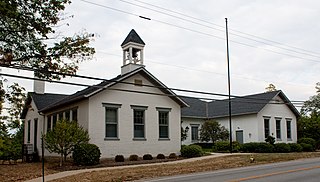
The Jefferson Schoolhouse is a historic one-room school in the Village of Indian Hill, Ohio, United States. Built along Drake Road in 1851, it is Indian Hill's oldest extant school. Three early schools, known as the Franklin, Jefferson, and Washington Schools, were established within the bounds of the modern community, but only the Jefferson School remains to the present day.

Anderson Schoolhouse is a registered historic building near Ashland, Ohio, listed in the National Register of Historic Places on 1977-03-25. It is located at 1202 US 42 South, in Milton Township, Ashland County, Ohio. It was known as the No. 5 district out of seven in the township.
Coleville School District No. 3645 was created to educate students in the area of Coleville, Saskatchewan. The school district operated from 1913 to March 6, 1946, when it became a part of the consolidated Kindersley School Unit.

Pleasant Valley School in Bellvue, Colorado is a one-room rural schoolhouse that was built in 1879. Its foundation and walls were built of sandstone from a nearby quarry. It has a front-gabled simple roof with wide overhanging eaves.

The District #2 Schoolhouse, known locally as the Garfield School and also known as Brunswick District No. 2 School, located in Brunswick, New York, United States, is a two-room schoolhouse built and opened in 1881. It hosted local students until the consolidation of Brunswick (Brittonkill) Central School District in the mid-1950s. It was added to the National Register of Historic Places (NRHP) in 1988, becoming the first building in the Town of Brunswick to be added to the Register. It is the current home of the Brunswick Historical Society.

The historic Abbe Creek School is a one-room schoolhouse museum located one mile west of Mt. Vernon, Iowa, on E48. It is believed to be the oldest standing one room brick schoolhouse in Iowa. The school is located on land claimed by William Abbe, the first white settler in Linn County, Iowa.
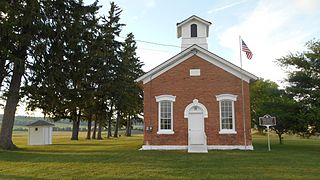
Overackers Corners Schoolhouse is a historic school located at Middlesex in Yates County, New York. It is an Italianate style structure built about 1874. The school reopened in 1998 after renovation by the Middlesex Heritage Group.

Indian Rock Schoolhouse, also known as District 3 Schoolhouse or Webutuck Country Schoolhouse, is located on Mygatt Road in the hamlet of Amenia, New York, United States. It is a wooden one-room schoolhouse built in the mid-19th century in accordance with a standard state plan for small rural schools that reflected contemporary educational reform movements.

Butler School is a historic building in Oak Brook, Illinois. Frank Osgood Butler donated the land for the two-room schoolhouse in the late 1910s. The building became a meeting place for locals, and hosted the first club to use the term "Oak Brook" to refer to the surrounding settlement. The former school was briefly used as the village hall, police station, and library, until new buildings were constructed for those purposes in the 1970s. It was added to the National Register of Historic Places in 2003.

Forest Grove School No. 5 is an historic building located near Bettendorf, Iowa, United States. It was listed on the National Register of Historic Places in 2013.
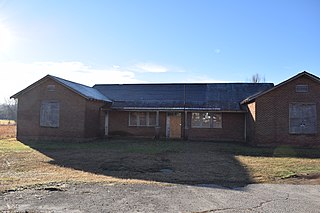
Pocahontas School is a historic school building in Pocahontas, Tennessee, that is listed on the National Register of Historic Places.
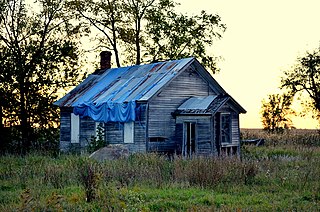
Wilson District No. 7 School, also known as the O'Meara Schoolhouse, is an historic structure located in rural Clinton County, Iowa, United States near the town of Delmar. The one-room school was listed on the National Register of Historic Places in 2004. The listing includes three structures: the former school building and two outhouses.
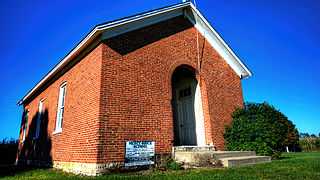
McGee School, also known as Coffin's Grove Township, District #1, is a one-room schoolhouse located west of Manchester, Iowa, United States. Built in 1868 in a folk-vernacular style, it is a rare example of a brick one-room schoolhouse in Iowa, and the only on left in Delaware County. Also rare is the tall Romanesque arched entryway, which led to a cloakroom on either side. The building is also significant as the only known school associated with Sarah Gillespie Huftalen, a rural school advocate and educator, who taught here from 1883 to 1884. It was listed on the National Register of Historic Places in 1999.

The Upper Stone Schoolhouse, also known as the Scott House, is a historic One-room schoolhouse located east of Vinton, Iowa, United States. Built in 1875, this is an unusual example of a stone one-room school. There was only one other built in Benton County, about 2 miles (3.2 km) to the southeast. The stone schoolhouse was replaced by a wood frame building to the south sometime between 1905 and 1910 to accommodate the large number of students. It served eight rural sections of farmland from the time. The Scott family, who owned the adjacent farmland, bought the stone school building after it closed and converted it into a house. It was listed on the National Register of Historic Places in 1983.

Mann School No. 2, also known as Sioux Township #2, is a historic building located west of Moorhead, Iowa, United States. Built in 1884, the building is a simple rectangular frame structure with a gable roof. Originally three bays long, an addition in the 1920s that added a cloak room and internal stairway to the basement, extended it one more bay. Located in the Loess Hills, this school differed from one-room schoolhouses on the prairie, in that it was located near the center of a cluster of families rather than at the center of four sections. Parents of the students who were educated here took responsibility for the upkeep and maintenance of the building and grounds. The building remained in use as a school until 1945 when the teacher expectantly left. Enrollment had been low to begin with so the district sent the students to a neighboring rural school and then to Moorhead. The building continued as a polling place after the school was formally closed in 1945. It was listed on the National Register of Historic Places in 2001.

The Pleasant Lawn School Historic District is a nationally recognized historic district located northeast of Mount Pleasant, Iowa, United States. It was listed on the National Register of Historic Places in 1987. At the time of its nomination it consisted of three resources, all of which are contributing buildings. This is the only intact example of a consolidated rural school district in Iowa. It consists of a two-story brick school building (1917), a two-story frame teacherage (1917), and a hack barn. A gymnasium was added to the school building in 1941. The school was still in existence when the buildings were added to the National Register.

Beach School is a historic building located northwest of Mount Vernon, Iowa, United States. Because school district lines had been redrawn, students in this area were forced to attend classes in a building some distance away. Given the condition of rural roads in the late 19th century, that created a hardship for many families. From 1889 to 1891 the school district set aside funds for a new building, and Benjamin Beach donated land on his farm for the new school. Not only was his farmhouse nearby, but Beach also operated a sawmill along the creek east of the school and a gristmill across the road. The one-room schoolhouse was completed in 1892, and a bell was purchased for the building around 1901. Early drawings of the building show a small bell tower. The building was used for educational and social use until 1946, and it has subsequently been converted into a rental home. It was listed on the National Register of Historic Places in 1982.

The Galen Elementary School is a historic building in Macon County, Tennessee. It was built by Jimmy Bohanon in 1928–29. It was a two-year feeder high school until 1960, when it closed down. One of the teachers was Harold Blankenship, who was interviewed in 1991. The building has been listed on the National Register of Historic Places since February 22, 1993.

The Espanola Schoolhouse is a one-story; one-room rural school building that has survived from the Jim Crow racial segregation-era. It is the last standing one-room schoolhouse in Flagler County. It is located at 98 Knox Jones Avenue, Bunnell, Florida 32110.





















